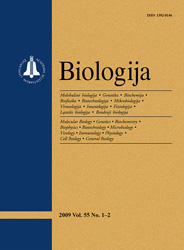Biologija / Biology
 ISSN 1392-0146 ISSN 2029-0578 (online) |
2007 m. Nr. 3 New thiazolidones-4 with sulfamethizole-2 substituent as
potential antifungal and antimicrobial preparations
The growing number of semi-synthetic penicillin analogues and other antibiotics known to have the chemical structure of classic antimicrobial drugs (such as sulfonamides), as well as the increasingly pressing problem of bacterial resistance urged us to investigate new sulfanilamide derivatives. Therefore, it is of therapeutic interest to design compounds containing three or more pharmacophores in their molecule. The initial 5-substituted-2-methylmercaptothiazolidin-4-ones were subjected to S-demethylation to yield 2-aminosubstituted thiazolidinones. As pharmacophoric amino or aldehyde group containing compounds, sulfamethizole, nitrofuran aldehydes and nitrobenzene aldehydes have been used. Antimicrobial (antifungal) activity of the new compounds was screened in vitro in the following bacterial cultures: Staphylococcus aureus ATCC 25923, Escherichia coli ATCC 25922, Bacillus subtilis ATCC 6633, Klebsiella pneumonine ATCC 33499 and fungal cultures: Candida albicans ATCC 60193, Candida glabrata, Candida krusei, Candida kefyr ATCC 8614, Candida tropicalis ATCC 8302, Candida parapsilosis. The results have shown that, statistically, the new compounds are significantly more effective as antimicrobial agents than the initial preparations. Their minimal inhibitory concentration (MIC) varies in the range 50–750 μg/ml and is 1.5 to 8 times higher than susceptibility of the initial compound. N-4 substituted sulfanilamide groups were not only effective against numerius gram-positive and some gram-negative bacteria, but also a spectrum of action against fungi has been discovered. The obtained results allowed to separate a promising group of potential antiinfectives possessing a higher antimicrobial and antifungal activity against some fungi and microbes than the initial compound.
Keywords: antifungal agents, antimicrobial agents, sulfanilamides, nitrofurans, synthesis of new drugs, antimicrobial susceptibility, antifungal susceptibility, nitrofural, sulfamethizole |
Issues:
2011 - Vol.57 No. 1, No. 2, No. 3 2010 - Vol.56 No. 1-4 2009 - Vol.55 No. 1-2, No. 3-4 2008 - Vol.54 No. 1, No. 2, No. 3, No. 4 2007 - Vol.53 No. 1, No. 2, No. 3, No. 4 2006 No. 1, No. 2, No. 3, No. 4 2005 No. 1, No. 2, No. 3, No. 4 2004 No. 1, No. 2, No. 3, No. 4 2003 No. 1, No. 2, No. 3, No. 4 2002 No. 1, No. 2, No. 3, No. 4 2001 No. 1, No. 2, No. 3, No. 4 |